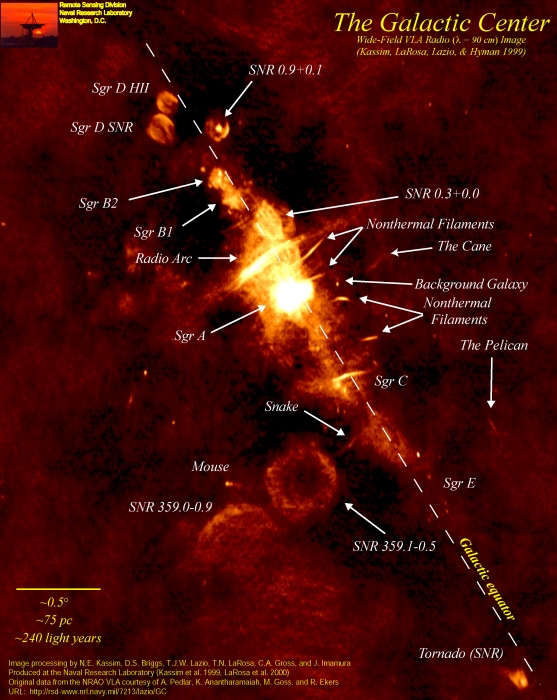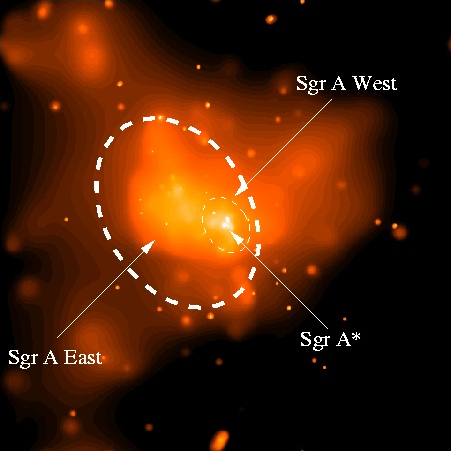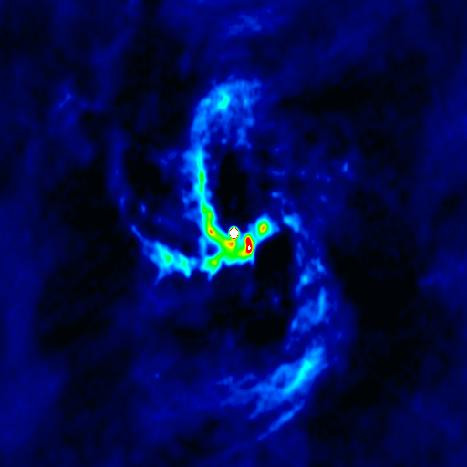Additional reading from www.astronomynotes.com
The very center of our Galaxy in the core of the bulge is located in the direction of the constellation Sagittarius. The dust gets thicker and thicker as we look into the center of the Galaxy, so the best options for observing the Galactic center are in radio waves and in infrared light. Researchers from the Naval Research Laboratory used data taken by the National Radio Astronomy Observatory's Very Large Array to produce an image of the Galactic Center in radio waves, shown here.

Several of the objects visible in this region are labeled Sagittarius (or Sgr for short) A, B, C, etc., which were the simple names given to bright features apparent in lower resolution images. The objects with SNR in their names are supernova remnants, which should indicate that this is a region of the galaxy where there are young, massive stars forming. Clearly, this is a very complex region of the Milky Way with many overlapping structures. However, astronomers have used many different types of observations at different wavelengths in an effort to reveal even more about the Galactic Center. For example, the below image from the Chandra X-Ray Observatory, taken by Penn State Professor Emeritus Gordon Garmire's team, reveals that Sgr A can be further reduced to a few sources, including a bright, small source called Sgr A*:

If we return to radio observations of Sgr A, the image below is from the Very Large Array, and it shows that in the central few parsecs there is a spiral structure made up of gas that is surrounding the central point source (Sgr A*). The gas appears to be rotating around Sgr A*, which is a clue about the nature of this object.

Now let us consider the nature of Sgr A* in particular. This object emits a large amount of radiation in IR, X-rays, and gamma-rays. It appears to be motionless, but we see gas apparently orbiting the source. Recently, observations of stars also found to be orbiting Sgr A* have given us significant new insight into the nature of this object. See UCLA's Galactic Center Group Animation of the Stars Orbiting Sgr A*.
Using the highest resolution IR cameras available, astronomers have repeatedly observed the stars orbiting around Sgr A*. They have measured the orbit of a star that comes within 17 light-hours of the object in the core of our Galaxy, which is a distance that is only a few times larger than the orbit of Pluto around the Sun. Using Kepler's laws, if we measure the period and semi-major axis of this star's orbit around Sgr A*, we can calculate the mass of this object. The mass that results from the study of this star and other nearby stars is 4 million solar masses! The only type of object that astronomers believe can have a mass of approximately 4 million stars, but a radius of about 100 AU, is a black hole. Clearly the supernova explosion of one star could never produce a single black hole with a mass so large, so this object must have formed in a different manner. Sgr A* is one example of a class of objects called Super-Massive Black Holes, or SMBHs.
In the context of the Milky Way as a whole, Sgr A* is considered to be the very center of the Galaxy. However, you must keep in mind that this object is found in the central ~100 AU of a galaxy that is something like 30 kiloparsecs or more in radius, so in every image you have seen so far of the Milky Way Galaxy, Sgr A* would be much smaller than the single pixel in the center of the image.